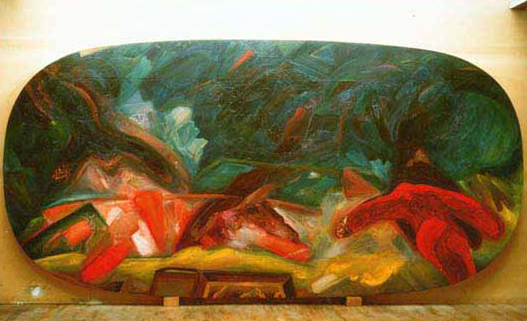(Above: Installation view, San Francisco loft - click image to view painting)
Remembering Julius Hatofsky
By Hilton Kramer
The American artist Julius Hatofsky, who died in Vallejo, California, on January 1st at the age of 83, was one of the most accomplished painters of his generation. Like many of the abstract artists of his generation, he preferred painting “big”: To accommodate the oversize scale of his paintings, many of which were 30-feet wide, he created huge studios early on in Hoboken, New Jersey, and then a 5,600 square-foot loft in California that were beautifully designed architectural spaces. Before relocating to San Francisco, he had two exhibitions at the legendary gallery of Charles Egan in New York.
Writing in The New York Observer in January 1994 on the occasion of his exhibitions at the Monterey Peninsula Museum of Art and the d.p. Fong Galleries in San Jose, California, I wrote: “I had long thought Mr. Hatofsky one of the most unjustly neglected painters on the American art scene, but now suddenly I realized he was a real master whose work almost nobody knows.” I still believe that to be the case.
He was born in Ellenville, in upstate New York, in 1922, and first studied Art as a teenager in the W.P.A. art classes. Later he studied at the Art Students League of New York (1946-1950) and the Grande Chaumiere in Paris (1950-1951), returning to New York to study at the Hans Hofmann School in 1952. At the League he studied with Morris Kantor and Robert Beverly Hale.
Yet it has to be said about Hatofsky as a painter that he remained an independent spirit whose art resembled that of no other living artist. The greatest influence on the work of his maturity was that of the Old Masters – among them Tintoretto, Turner, Blake, Goya, Ryder and Delacroix.
What must also be recalled about Hatofsky was his varied experience beyond the art world. While still a young man he worked as a New York City police officer. Later, in World War II, he served in the 82nd Airborne Division, landing by glider in crucial battles – among them Arnhem, the Normandy Invasion and the Battle of the Bulge. In 1945 he took part in liberating a concentration camp.
Hatofsky was a beloved and respected teacher of painting and drawing at the San Francisco Art Institute (1962-1995). When he retired from teaching, former students contributed $20,000 to create and publish a catalogue of his work. Hatofsky was also an extraordinary craftsman. The tables he created must be added to his accomplishments. He was fascinated by the beauty and variety of woods, and crafted beautiful tables with images of nature and abstract figures in them. He used the grains and colors of exotic woods as his palette, and created inlaid tables that are works of art.
Julius Hatofsky is survived by his wife Linda Spector, a brother Jack Hadley, and a nephew Steve Benjamin. A gathering celebrating Julius will be held at Sweeties Art Bar, 475 Francisco Street, San Francisco on March 4, 4:00-9:00pm.
